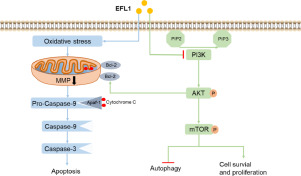当前位置:
X-MOL 学术
›
Phytomedicine
›
论文详情
Our official English website, www.x-mol.net, welcomes your
feedback! (Note: you will need to create a separate account there.)
Effect of euphorbia factor L1 on oxidative stress, apoptosis, and autophagy in human gastric epithelial cells.
Phytomedicine ( IF 6.7 ) Pub Date : 2019-04-16 , DOI: 10.1016/j.phymed.2019.152929 An Zhu 1 , Yuqing Sun 1 , Qianwen Zhong 1 , Jinlan Yang 1 , Tao Zhang 1 , Jingwei Zhao 1 , Qi Wang 2
Phytomedicine ( IF 6.7 ) Pub Date : 2019-04-16 , DOI: 10.1016/j.phymed.2019.152929 An Zhu 1 , Yuqing Sun 1 , Qianwen Zhong 1 , Jinlan Yang 1 , Tao Zhang 1 , Jingwei Zhao 1 , Qi Wang 2
Affiliation

|
BACKGROUND
Euphorbia factor L1 (EFL1), a lathyrane-type diterpenoid from the medicinal herb Euphorbia lathyris L. (Euphorbiaceae), has been reported for many decades to induce gastric irritation, but the underlying mechanisms remain unclear.
PURPOSE
The objective of this study was to investigate EFL1-induced cytotoxicity and the potential mechanisms of action on the human normal gastric epithelial cell GES-1.
METHODS
GES-1 cells were treated with EFL1 (12.5-200 μM) for different time intervals, and cell survival, LDH release, intracellular reactive oxygen species (ROS), malondialdehyde (MDA) content, and superoxide dismutase (SOD) activity were detected. Mitochondrial membrane potential (MMP) assay, DAPI staining, DNA fragment assay, and annexin V-FITC/PI staining were performed. The interaction between EFL1 and Bcl-2, cytochrome c, caspase-9, caspase-3, PI3K, AKT, and mTOR proteins was simulated by molecular docking. The mRNA and protein expression of apoptosis and autophagy factors were detected by RT-qPCR and Western blotting.
RESULTS
EFL1 decreased survival, increased LDH leakage, and induced abnormal production of ROS, MDA and SOD in GES-1 cells. Mitochondria-mediated apoptosis was characterized by decreased MMP, condensed nuclei, fragmented DNA, and increased apoptosis rate. EFL1 interacted with proteins via hydrogen bonding. The mRNA, total or phosphorylated protein expression of Bcl-2, mitochondrial cytochrome c, PI3K, AKT, mTOR and p62 were downregulated; in contrast, those of cytoplasmic cytochrome c, cleaved caspase-9, cleaved caspase-3, LC3-ll and Beclin-1 were upregulated.
CONCLUSION
These findings indicated that EFL1 decreased the survival of GES-1 cells through EFL1-induced oxidative stress, activation of the mitochondria-mediated apoptosis as well as autophagy via inhibition of the PI3K/AKT/mTOR pathway.
中文翻译:

大戟因子L1对人胃上皮细胞氧化应激,细胞凋亡和自噬的影响。
背景技术大戟因子L1(EFL1)是来自药用大戟Euphorbia lathyris L.(Euphorbiaceae)的一种Lathyrane型二萜类化合物,已有数十年的报道可引起胃刺激,但其潜在机制尚不清楚。目的本研究的目的是研究EFL1诱导的细胞毒性以及对人正常胃上皮细胞GES-1的潜在作用机制。方法用EFL1(12.5-200μM)处理GES-1细胞不同的时间间隔,并检测细胞存活率,LDH释放,细胞内活性氧(ROS),丙二醛(MDA)含量和超氧化物歧化酶(SOD)活性。 。进行了线粒体膜电位(MMP)测定,DAPI染色,DNA片段测定和膜联蛋白V-FITC / PI染色。EFL1和Bcl-2,细胞色素c,胱天蛋白酶9,通过分子对接模拟了caspase-3,PI3K,AKT和mTOR蛋白。RT-qPCR和Western blotting检测凋亡和自噬因子的mRNA和蛋白表达。结果EFL1降低了存活率,增加了LDH泄漏,并诱导GES-1细胞中ROS,MDA和SOD的异常产生。线粒体介导的凋亡的特征在于MMP降低,细胞核浓缩,DNA片段化和凋亡率增加。EFL1通过氢键与蛋白质相互作用。Bcl-2,线粒体细胞色素c,PI3K,AKT,mTOR和p62的mRNA,总蛋白或磷酸化蛋白表达下调。相反,细胞质细胞色素c,裂解的caspase-9,裂解的caspase-3,LC3-II和Beclin-1的那些被上调。
更新日期:2019-04-16
中文翻译:

大戟因子L1对人胃上皮细胞氧化应激,细胞凋亡和自噬的影响。
背景技术大戟因子L1(EFL1)是来自药用大戟Euphorbia lathyris L.(Euphorbiaceae)的一种Lathyrane型二萜类化合物,已有数十年的报道可引起胃刺激,但其潜在机制尚不清楚。目的本研究的目的是研究EFL1诱导的细胞毒性以及对人正常胃上皮细胞GES-1的潜在作用机制。方法用EFL1(12.5-200μM)处理GES-1细胞不同的时间间隔,并检测细胞存活率,LDH释放,细胞内活性氧(ROS),丙二醛(MDA)含量和超氧化物歧化酶(SOD)活性。 。进行了线粒体膜电位(MMP)测定,DAPI染色,DNA片段测定和膜联蛋白V-FITC / PI染色。EFL1和Bcl-2,细胞色素c,胱天蛋白酶9,通过分子对接模拟了caspase-3,PI3K,AKT和mTOR蛋白。RT-qPCR和Western blotting检测凋亡和自噬因子的mRNA和蛋白表达。结果EFL1降低了存活率,增加了LDH泄漏,并诱导GES-1细胞中ROS,MDA和SOD的异常产生。线粒体介导的凋亡的特征在于MMP降低,细胞核浓缩,DNA片段化和凋亡率增加。EFL1通过氢键与蛋白质相互作用。Bcl-2,线粒体细胞色素c,PI3K,AKT,mTOR和p62的mRNA,总蛋白或磷酸化蛋白表达下调。相反,细胞质细胞色素c,裂解的caspase-9,裂解的caspase-3,LC3-II和Beclin-1的那些被上调。


















































 京公网安备 11010802027423号
京公网安备 11010802027423号